
Home
Studies
& Data Analysis
Methods
Microscope studies
Flagella experiment
Laboratory math
Blood fractionation
Gel electrophoresis
Protein gel analysis
Mitochondria
Concepts/ theory
Keeping a lab notebook
Writing research papers
Dimensions & units
Using figures (graphs)
Examples of graphs
Experimental error
Representing error
Applying statistics
Principles of microscopy
Solutions & dilutions
Protein assays
Spectrophotometry
Fractionation & centrifugation
Radioisotopes and detection
Examples of Notebook Pages and Entries
Here are examples of a title page and specific notebook entries. The work may be ancient history but as an example of recordkeeping this mateiral may be far more effective than general guidelines in delivering the message.
- Sample title page
- Sample table of contents
- Page 1: introducing an experiment; reference to published methods; recording of procedures
- Page 2: continuing an experiment on the next page; correcting a mistake; how to void 'white space'
- Page 3: summarizing a day's work; continuing an experiment on a future nonadjacent page
- Page 6: perform calculations directly in the notebook; summarize formulas for future reference; leave mistakes in the book - don't obscure them
- Page 14: recording different procedures on the same page; continuing from a previous nonadjacent page; adding a comment to previous notes; reference to previously recorded procedures; reserving a place for an attached document
Cover and title page
Laboratory Record
David R. Caprette
Department of Biochemistry & Cell Biology
Rice University
211A Anderson Biology Lab
6100 S. Main
Houston, Texas 77005
(555) 555-5555
Table of Contents
Reserve several front pages for contents by indicating their purpose at the top of the page. Do not leave completely blank pages in the front of the notebook, for future tables, since blank pages could also be used to add entries out of order. If pages are not pre-numbered, it may be convenient to use small case Roman numerals to number the contents pages. Record contents in chronological order.
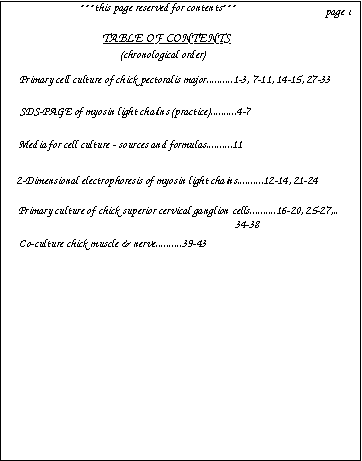
Page 1
Always date and number every page in a consistent manner (e.g., at the top right, or bottom center, etc.). Start every experiment with a title and a brief introduction. Follow with "procedures," "materials and methods," or whatever you choose as the title for your laboratory work.
Document procedures within a reasonable time of doing them - during busy times your memory can fail you. Even if a procedure is outlined in a paper or published laboratory manual, record all of your procedures the first time you do them. Record HOW each procedure is done, even such mundane procedures as pipetting, calibrating a spectophotometer, or finding cells in a microscope. That is the only way you will be able to catch possible mistakes later, modify your procedures, or report exactly what you did. Do all of your calculations and take all notes right there in the notebook. Never do calculations or record observations on 'lab stationery' (paper towels). Loose papers can be lost easily.
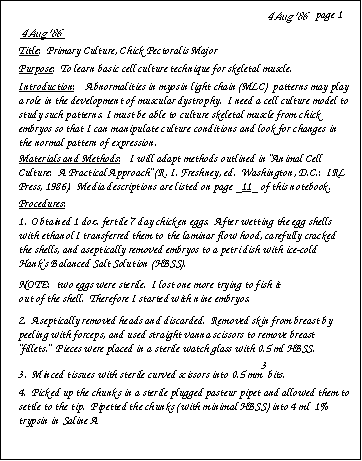
Page 2
Include the date at the top of the page even if it is the same day as on the previous page.Never mark anything out so as to obscure what was written, no matter how sloppy or 'dumb' it looks. Writing disparaging remarks about your insructor or supervisor is a bad idea. You will be in trouble if you obscure the remark, but could be in even more trouble if you leave it in!
Any significant amount of blank space must be voided by drawing a corner-to-corner line through the space. This 'rule' is there to ensure that your notebook is a legal record of lab activities. If you fail to void a blank space, you could go back and change something, that is, you could falsify your record.
In labs doing proprietary research (confidential- such as industrial research for profit) a properly maintained notebook is essential. You and a supervisor sign and date each page, and an independent person checks it periodically, say, once per week. The notebook is a legal document that can protect your rights to your work. For example, if you 'beat' another lab to a patentable discovery by just one day, your notebook will be the legal proof you need.
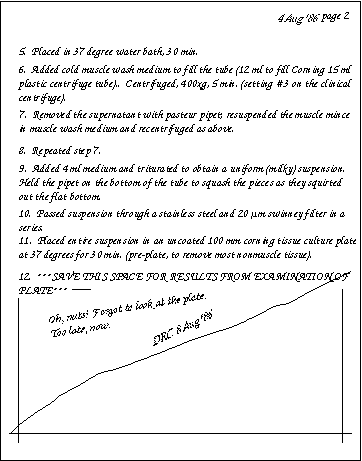
Page 3
In this example, the project was not complete. I wrote a very brief summary, all the same. Following the last entry I wrote ***continued, page ____**** because I knew that the project would be interrupted chronologically. Later, when the project was resumed, I filled in the blank with the number of the page on which I recorded the very next set of information. This way, you never need to reserve space for further entries. Record everything you do, even for different projects, in chronological order.
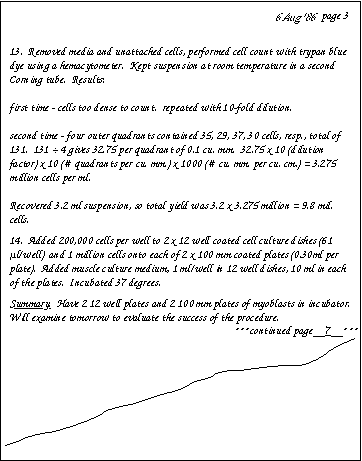
Page 6
When you make calculations, such as when you prepare a solution for the first time, write down all of your raw calculations. Even if you make mistakes, your progress is recorded permanently. Raw calculations may make your notebook appear a bit 'sloppy,' however if you don't include them you can't go back and correct mistakes.
When you have a 'recipe' that you anticipate using again, summarize the formula. You may want to include page numbers of all such recipes in a special place in your table of contents (reference materials need not be in chronological order).
Sometimes you just plain have a bad day. Consider that someone else may have a legitimate reason for examining your notebook. Don't put something in there that could embarrass you later. Remember, you can't blot anything out or rip out pages!
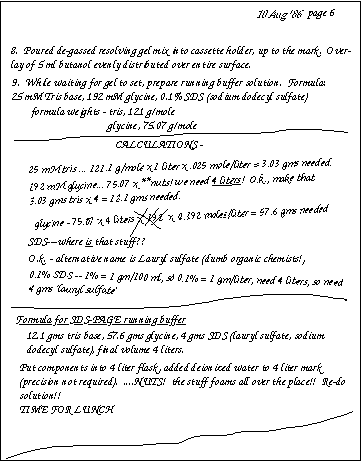
Page 14
When you really start cranking on a couple of projects, your notebook fills up fast. I used to have about four different things going at once. I didn't simply go outside and sun myself every time I had a one hour wait during a protocol. I worked on something else.
When you switch from one project to another you need to continue to record your activities chronologically. Done properly, it won't be confusing at all. You simply read each passage and follow the continuation notes to follow a single project from start to finish. Magazines do that all the time, to get around ads and to continue long articles. Just be consistent with the titles of your projects.
When you add notes later or correct a mistake, always initial and date your comment. Indicate clearly that this is an additional comment, such as by using a different color ink.
If you follow a previously recorded procedure exactly, you need not rewrite the entire protocol. Just refer to the protocol by page number(s) or by a title. As with projects, be consistent with the names of protocols, formulas, etc.
Sometimes you will want to attach a photograph, sketch, graph, or some other document that is not conveniently written directly in your notebook. Reserve a place for attachment of such document, and you can staple or tape it right there. Just don't hide any of your entries.
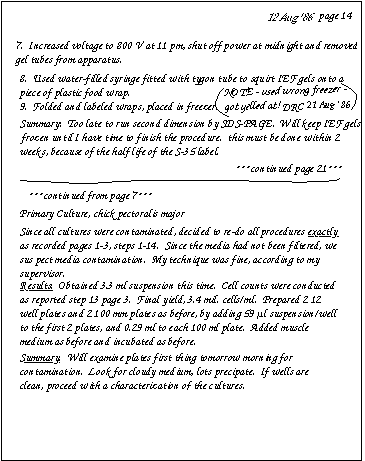
Visitors: to ensure that your message is not mistaken for SPAM, please include the acronym "Bios211" in the subject line of e-mail communications
Created by David R. Caprette (caprette@rice.edu), Rice University Dates
